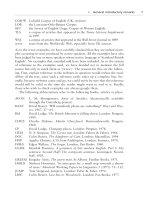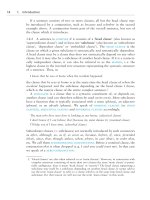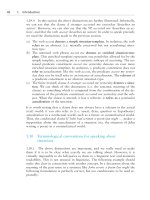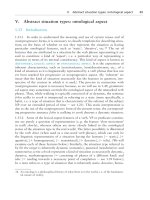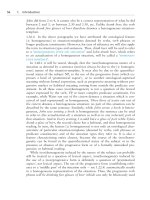The grammar of the english verb phrase part 4 docx
Bạn đang xem bản rút gọn của tài liệu. Xem và tải ngay bản đầy đủ của tài liệu tại đây (77.6 KB, 7 trang )
14 1. Introduction
If a sentence consists of two or more clauses, all but the head clause may
be introduced by a conjunction, such as because and whether in the second
example above. A conjunction forms part of the overall sentence, but not of
the clause which it introduces.
1.8.2 A sentence is
complex if it consists of a ‘head clause’ (also known as
‘superordinate clause’) and at least one ‘subclause’ (also known as
‘subordinate
clause’, ‘dependent clause’ or ‘embedded clause’). The
head clause is the
clause on which a given subclause is syntactically and semantically dependent.
A head clause may be a clause that does not syntactically depend on any other
clause, but it may also be a subclause of another head clause. If it is a syntacti-
cally independent clause, it can also be referred to as the
matrix,i.e.the
highest clause in the inverted tree structure representing the syntactic structure
of a sentence. Thus, in
I know that he was at home when the accident happened.
the clause that he was at home is at the same time the head clause of when the
accident happened and the subclause depending on the head clause I know,
which is the matrix clause of the entire complex sentence.
2
A subclause is a clause that is a syntactic constituent of, or depends on,
another clause (and can therefore seldom be used on its own). Most subclauses
have a function that is typically associated with a noun (phrase), an adjective
(phrase) or an adverb (phrase). We speak of
nominal clauses (or noun
clauses
), adjectival clauses and adverbial clauses accordingly.
The man who lives next door is looking at our house. (adjectival clause)
I don’t know if I can believe that [because my sister denies it]. (nominal clause)
I’ll help you if I have time. (adverbial clause)
Subordinate clauses (ϭ subclauses) are normally introduced by such connectors
as after, although, as, as if, as soon as, because, before, if, once, provided
(that), since, that, though, unless, when, where, in case (that), in order that,
etc. We call them
subordinating conjunctions. Before a nominal clause, the
conjunction that is often dropped (e. g. I said you could trust me). In that case
we speak of a
zero-conjunction.
2. ‘Head clauses’ are also often referred to as ‘main clauses’. However, in connection with
complex sentences consisting of more than two clauses the term ‘main clause’ is poten-
tially ambiguous: does it mean ‘head clause’ or ‘matrix’? The head clause supporting a
subclause may itself be a subclause depending on another head clause. It seems odd to
use the term ‘main clause’ to refer to a clause which is at the same time head clause and
subclause. For that reason we will not use the term ‘main clause’ in this work.
II. General linguistic terminology 15
1.9 Alternative definitions of ‘verb phrase’
In 1.7 we have defined the VP as that part of the predicate constituent that
does not contain optional adverbials. (In many cases the predicate consists of
a VP only.) We will stick to this definition in this work. However, it may be
useful to know that some linguistic works use the term in a different sense.
Some use it in the sense of our ‘predicate (constituent)’, i. e. to refer to the sum
of all those constituents of the clause that do not belong to the subject NP.
Others use the term in a much narrower sense, to denote no more than the
main verb and any auxiliaries accompanying it. Thus seen, the VP of He may
have been reading a book is may have been reading (rather than may have
been reading a book). In the present work a string like may have been reading
or will read will be referred to as a ‘verb form’. A
verb form consists either
of a verb (in the form of a participle or infinitive) plus one or more auxiliaries
(e. g. will see, would have seen) or of a (usually inflected) verb only (as in They
take drugs, John smokes).
1.10 Tensed vs nontensed verb forms
1.10.1 As far as English is concerned, only finite verb forms are tensed.The
term
finite (which means ‘limited’) refers to a verb form that is marked for
tense and potentially also for other grammatical categories like mood, person
and number. (These markings limit the possibilities of using the form). For ex-
ample:
works (marked for tense, mood, person and number: present tense, indicative mood,
third person, singular)
drank (marked for tense and mood only: past tense, indicative mood) (unmarked
for person and number)
The form works is more limited in applicability than drank, since it cannot be
used, say, with a plural subject. Drank can be used in a wider range of gram-
matical environments, but it cannot be used in a situation in which a present
tense form is required. Being marked for tense apparently stands out as a neces-
sary defining feature of finite verb forms in English.
1.10.2 Because of the crucial importance of being marked for tense, finite
verb forms are by definition indicative forms. Compare:
They were in the kitchen.
John wished he were somewhere else.
In the first example, were is an indicative form because it is tensed: it is a past
tense form locating the time of the state referred to in the past. In the second
16 1. Introduction
example, were is a subjunctive form. Though traditionally called ‘past sub-
junctive
’ (because of the formal contrast with the ‘present subjunctive’ be
and the fact that it has the same form as the past indicative form were), the
subjunctive form were is not tensed, because it does not express or imply any
temporal relation between the time of the situation referred to (ϭ John’s being
somewhere else) and the time of speech.
1.10.3 In later chapters we will distinguish between ‘absolute’ and ‘relative’
past tense forms (see especially 8.23Ϫ32). The former relate the time of a
situation directly to the ‘
temporal zero-point’t
0
(which is usually the time
of speech Ϫ see 2.4), whereas the latter relate it to another ‘
orientation time’.
Thus, John suddenly complained that he felt ill is analysed as having an abso-
lute tense form complained, which locates the complaining in the past (relative
to the time of speech), and a relative tense past form felt, which represents the
situation of John feeling ill as simultaneous with the situation referred to by
complained. It might seem as if the past subjunctive were did the same job in
John wished he were somewhere else, but this is not true: whereas a relative
past tense form can only express simultaneity with a past time of orientation,
3
the past subjunctive can express simultaneity with any time of orientation,
irrespective of whether it is past, present or future. Compare:
John {said / says / will say} that Bill was ill. (It is only after said that was is
interpreted as a relative past tense expressing simultaneity. After says and will say,
Bill was ill is interpreted as expressing that Bill’s illness is anterior to the present or
future time of saying.)
John {wished / wishes / will wish} he were somewhere else. (In all three cases the
subjunctive form were is interpreted as expressing simultaneity.)
It is clear from these examples that a relative past tense still has an ‘absolute
tense’ component (see 1.18) in its semantics: the time of orientation with which
a relation of simultaneity is expressed must form part of a ‘temporal domain’
(see 2.15) which is past with respect to the temporal zero-point.
4
The past
subjunctive does not share that semantic characteristic. This means that in spite
of expressing simultaneity, the subjunctive were is not a relative tense form.
Since, obviously, it is not an absolute tense form either (i. e. it does not relate
its situation to the temporal zero-point), it can only be treated as an ‘untensed’
form. In this respect it resembles nonfinite verb forms, i. e. infinitives, partici-
ples and gerunds.
3. This formulation is a simplification. As we will see in 8.12, the semantics of a relative
past is that it expresses simultaneity with a time of orientation in a past temporal domain
(or in a ‘pseudo-past subdomain’ Ϫ see 9.9.1).
4. As will become clear in 8.15, saying that a temporal domain is past relative to the zero-
point means that the ‘central time of orientation’ of the domain is past relative to the
zero-point.
II. General linguistic terminology 17
1.10.4 ‘Marked for tense’ or ‘tensed’ does not simply mean ‘carrying temporal
information’. Nonfinite verb forms may have a ‘perfect’ form, i. e. express ante-
riority (e. g. have eaten, having eaten). The point is that the time of orientation
to which they relate the time of their situation does not have to be the temporal
zero-point. It is criterial of tensed forms that they encode information concern-
ing the relation of the time of a situation to the temporal zero-point t
0
(which
is usually the time of speech Ϫ see 2.4), whether that relation is direct (as in
absolute tenses) or indirect (as in relative tenses). Subjunctive forms and non-
finite forms do not share this characteristic. They are therefore treated as
un-
tensed
(tenseless) forms.
1.11 ‘Present’ and ‘perfect’ nonfinite forms
1.11.1 There are two formal types of infinitives, illustrated by eat and have
eaten and traditionally referred to as
present infinitive and perfect infini-
tive
. These labels should not suggest that infinitives are tensed in the same
way as the present tense, the present perfect, the past perfect etc. are tensed:
infinitives are tenseless Ϫ see 1.10.4. However, it is true that the present and
perfect infinitives usually express simultaneity and anteriority respectively: in
He seems to be ill and He seems to have been ill, the being ill is located
simultaneous with or anterior to the time of the head clause situation, respec-
tively. We will therefore stick to the traditional labels ‘present infinitive’ and
‘perfect infinitive’ and consider them based on the form of the infinitive, while
keeping in mind (a) that ‘present’ and ‘perfect’ here have nothing to do with
tense, and (b) that on their default interpretation the present and perfect infini-
tives express simultaneity and anteriority (to the time of the head clause situa-
tion), respectively.
1.11.2 Similarly, there are two participle forms in English: the so-called
pres-
ent participle
and the past participle. Like ‘present infinitive’ and ‘perfect
infinitive’, these labels are not quite felicitous because ‘present’ and ‘past’ sug-
gest a distinction of tense, whereas participles are tenseless (like the other non-
finite forms). This means that present and past participles are not present or
past tense forms, and that they do not necessarily refer to present or past
time respectively. Consider for example the present participle causing in the
following sentences:
Any hotel guests causing a disturbance tonight will be asked to leave tomorrow.
The hotel guests causing a disturbance at the moment will be asked to leave immedi-
ately.
The hotel guests causing a disturbance last night will be asked to leave today.
18 1. Introduction
In each of these examples, the situation of asking those causing a disturbance
to leave is located in the future. The situation of their causing a disturbance,
however, is interpreted as lying in the future in the first case, in the present in
the second, and in the past in the third.
1.11.3 Like the infinitive and the participle, the gerund has two forms (e. g.
walking versus having walked), which we will label ‘
present gerund’ and
‘
perfect gerund’, respectively. The perfect gerund always expresses anteri-
ority, whereas, depending on the context, the present gerund can be interpreted
in terms of simultaneity, anteriority or posteriority:
I confirm being over 18 years of age. (www) (simultaneity reading)
Social workers confirmed being overwhelmed by child protection work. (www) (si-
multaneity reading)
[He seems to have been unaware of his sisters,] which appears to confirm being
orphaned at an early age. (www) (anteriority reading)
John has admitted {making / having made} a mistake last week. Now he regrets
{doing so / having done so}. (anteriority reading)
Certainly, it would have been hard to find anyone in the early 1960s who would
have anticipated him making such a blunder. (www) (posteriority reading)
1.12 Lexical verbs vs auxiliaries
1.12.1 Verbs can be classified in many different ways. The first distinction is
between those verbs that have a full set of forms and those that do not. This
distinction coincides roughly with the distinction between
lexical verbs (or
full verbs) and auxiliaries (or auxiliary verbs). These two groups show
differences on various levels (formal, semantic and syntactic). The following
offer some illustrations:
(lexical verbs) type, look for, cost, develop, begin, stand
(auxiliaries) must, should, can, might, be [V-ing], be [V-en], ought to
1.12.2 Lexical verbs, as their name suggests, have a lexical meaning, that
is, a meaning that is denotational (extralinguistic) rather than grammatical
(intralinguistic). They are verbs like burst, run, change and contain, which refer
to situations types of different kinds (events, actions, processes or states Ϫ see
1.42). Lexical verbs are sometimes called ‘
full verbs’, a term which is used
to indicate that they are syntactically ‘fully-fledged’ verbs (e. g. they can com-
bine with auxiliaries but can also do without them), that they have a full system
of verb forms (called ‘
conjugation’ Ϫ e. g. walk, walks, walked, walking) and
that they are semantically rich in that they evoke a set of concepts of things,
persons and circumstances which are needed for a correct understanding of
the verb.
II. General linguistic terminology 19
Lexical verbs form an ‘open’ (i. e. unlimited, productive) group. For exam-
ple, as the world around us changes, new verbs are coined to express new ways
to interact with it, such as google (“to search the Web using the search engine
Google for information on a person or thing”):
I didn’t know what a cosmopolitan was in the drinks world so I googled it and it
said something about it being for tarts. (www)
When we googled the combination I googled it on 19 March 2003, no fewer
than 473 links came up, indicating that this verb has found its way into the
English language. On 24 September 2003 I googled it produced 1,420 links
(and googled produced 38,100). Other additions are webcast and spam (the
web). New verbs also appear on the scene to express concepts that could al-
ready be expressed by other lexical items. Phrasal verbs (particle verbs), espe-
cially, provide a rich source of contributions to the expanding lexical stock of
English, as testified by recent creations like dumb down (ϭ ‘reduce the intellec-
tual content or capabilities of ’), as in They dumbed him down to make Jess
seem smarter (www), gross (someone) out (ϭ ‘revolt’) or ralph (one’s food) up
(ϭ ‘throw up’).
1.12.3
Auxiliaries have little or no lexical meaning. They are ‘helper’ verbs,
in the sense that they help to form complex verb forms. In doing so they
express either a grammatical notion (like ‘passive’, ‘progressive’ or ‘tense’) or
one or more modal ideas. This is not to say that auxiliaries are devoid of
meaning, but their meanings are more schematic (i. e. more ‘skeletal’, more
‘abstract’, less ‘full’) than those of lexical verbs.
Within the auxiliaries we can make a distinction between two classes:
gram-
matical auxiliaries
and modal auxiliaries. The former, which are some-
times referred to as ‘primary auxiliaries’, have a purely grammatical function:
(a) the ‘
tense auxiliary’ have, which is used in forming perfect tense forms;
(b) the ‘
aspect auxiliary’ be, which is used for building progressive verb
forms;
(c) the ‘
voice auxiliary’ be, which is used in the passive;
(d) the ‘
periphrastic auxiliary’ do, which is used as a ‘dummy’ (pro-form)
when a VP that does not contain an auxiliary (e. g. love her) is used in a
construction that requires one (e. g. I don’t love her, Do you love her?, I
do love her, etc.)
Next, there are the ‘
modal auxiliaries’: can, could, may, might, must, shall,
should, ought to, will, and would. These auxiliaries express special shades of
meaning, such as volition, possibility, permission, necessity, intention, obliga-
tion, expectation, inference, ability, determination, etc. The modal auxiliaries
differ semantically from the first group in that they add lexical meaning rather
than fulfil a grammatical function. However, they still have less concrete, and
20 1. Introduction
hence more widely applicable, meanings than most lexical verbs.
5
This wider
applicability explains why auxiliaries form a relatively small set when com-
pared with lexical verbs.
1.12.4 Because an auxiliary does not have a full lexical meaning, it cannot be
used without a main (lexical) verb, except in ‘
code’, where the auxiliary is
used as pro-form for an entire verb phrase (as in John will not be sleeping, but
I will). In other words, an auxiliary cannot be the only or last verb form in the
VP (except in ‘code’). In the following example the main verbs are italicized
while the auxiliaries are underlined:
[“What did he do last night?”] Ϫ “He {studied / worked / may have slept /*could /
*had to /*would}.”
1.12.5 Unlike lexical verbs, auxiliaries have the so-called ‘NICE-properties’.
‘NICE’ is an acronym (coined by Huddleston 1976) consisting of the initial
letters of the terms negation, inversion, code and emphasis. The reference is to
the four cases in which the English VP requires an auxiliary. If there is no
auxiliary, the ‘
periphrastic auxiliary’ do has to be added. In that case we
say that the lexical verb requires ‘
do-support’. In other words, the statement
that ‘auxiliaries have the NICE-properties’ means that they do not combine
with the periphrastic auxiliary do in clauses made negative by the use of not,
in clauses involving subject-auxiliary inversion, in code (see 1.12.4) and in cases
of emphasis. By contrast, clauses without an auxiliary need ‘do-support’ (i. e.
the insertion of do) in these four cases. Compare:
He went / He didn’t go / Did he go? / Yes he did / He did go.
He will go / He won’t go / Will he go? / Yes he will / He
will go.
1.13 Transitive vs intransitive lexical verbs
1.13.1 To be used grammatically in a normal declarative clause, lexical verbs
require one or more ‘
arguments’: a subject, sometimes called the ‘external
argument’ (because it does not belong to the predicate constituent), and pos-
sibly one or more ‘internal arguments’, usually called
complements, such as
5. This is a generalizing statement. Some full (ϭ lexical) verbs also have little lexical mean-
ing (semantic content), e. g. seem, be, appear (as a copula), look (as a copula), etc.
Moreover, some full verbs like want are on the way to becoming auxiliaries in that they
have a contracted form (I wanna go to Italy), which is characteristic of auxiliaries, not
of full verbs. The full verbs be and have also allow contraction, as in He’s fine or He’s
nothing to say. This means that the distinction between auxiliaries and full verbs is not
always sharp: they form a scale with prototypical auxiliaries (like must) at one end and
prototypical lexical verbs (like walk) at the other end.


